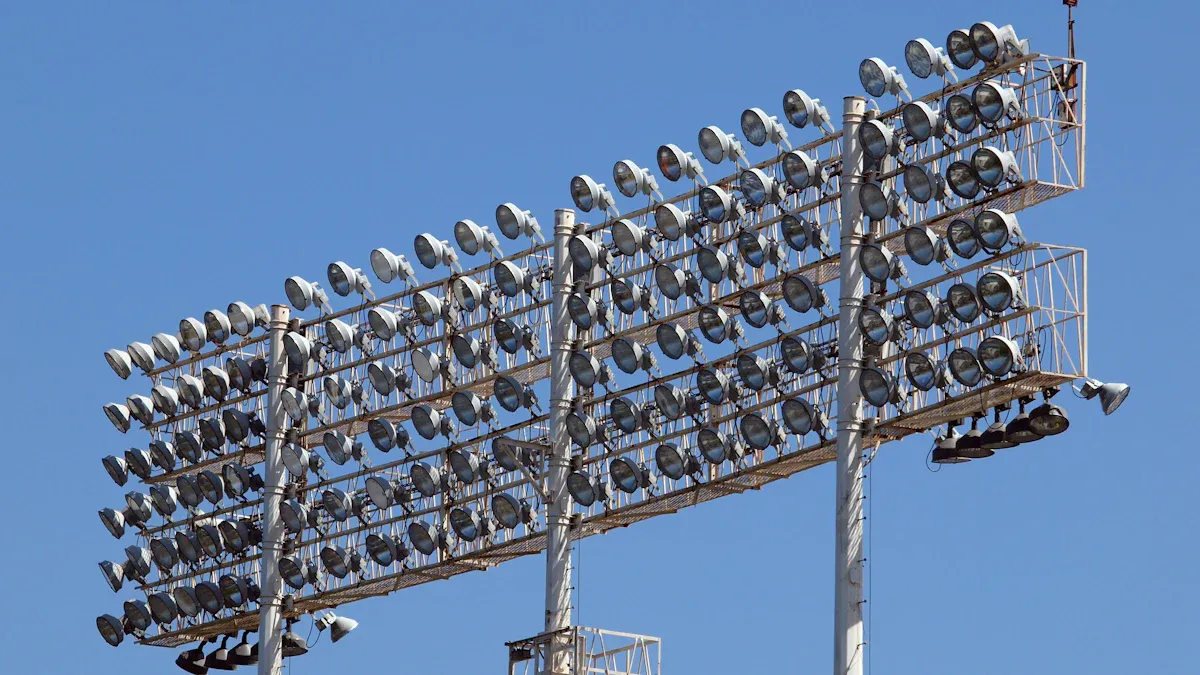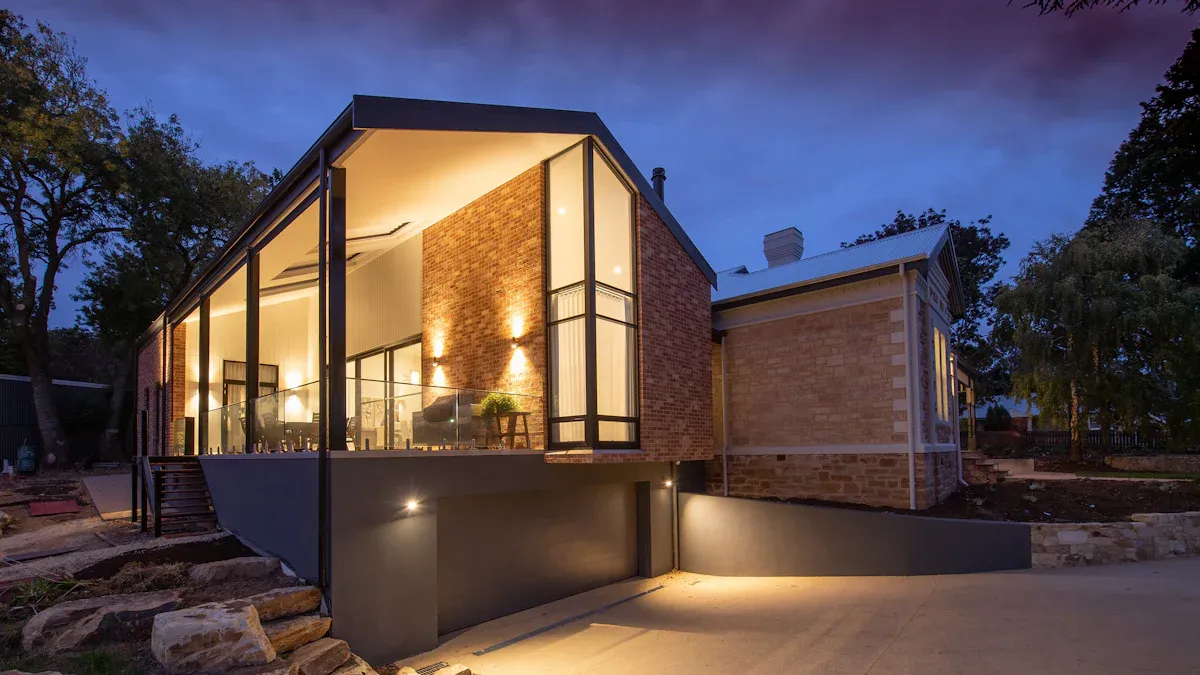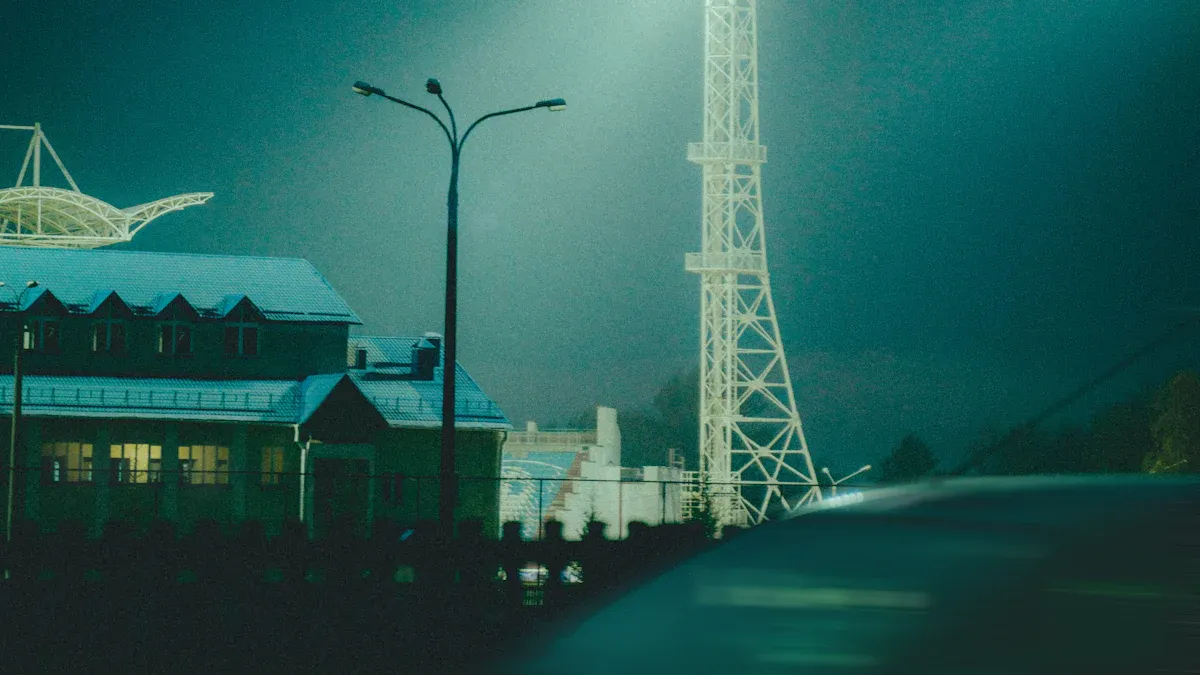Flood Lighting Systems: Professional Installation and Design Strategies for Commercial and Residential Properties

Flood lighting systems are essential for safety, security, and aesthetics. They help prevent accidents on roads and deter crimes in parking lots. For instance, bright parking areas equipped with LED lights make it easier to see and scare off potential threats. At home, these flood lighting systems enhance the appearance of gardens, driveways, and buildings, making them look more inviting. Businesses such as malls and offices utilize effective lighting to ensure the safety and satisfaction of their patrons.
Hiring experts to install and design these lighting solutions ensures optimal performance. Studies indicate that well-lit areas, especially those with cameras, experience a reduction in crime. For example, Humboldt Park reported a 20% decrease in criminal activity after implementing effective flood lighting systems. Additionally, using energy-efficient LED lights not only saves money but also benefits the environment.
Key Takeaways
Flood lights help keep homes and businesses safe. They stop crime and make dark places easier to see.
Experts should install flood lights for best results. They follow safety rules and avoid common errors.
LED flood lights use less energy and save money. They can lower power bills by up to 80% compared to old bulbs.
Place flood lights smartly to cover more space and avoid shadows. Focus on important spots like driveways and parking areas.
Take care of flood lights to keep them working well. Clean them often and check for damage so they last longer.
Understanding Flood Lighting Systems
Definition and Purpose
Flood lighting systems are bright lights that cover large spaces. They are often used outdoors to improve safety and visibility. Many modern flood lights, like LED ones, save energy and last a long time.
Feature/Benefit | Explanation |
|---|---|
Bright Lights | Flood lights brighten big areas with wide beams of light. |
Energy Saving | LED flood lights use less power and last longer. |
Uses | Found in homes, businesses, and sports areas for safety. |
Flood lights are mainly used for safety, work, and decoration. They keep intruders away by lighting up dark spots. They also make nighttime activities safer and highlight buildings or gardens for a nice look.
Key Benefits for Commercial Properties
Flood lights help businesses in many ways. They make places safer by scaring off criminals. Bright areas make it harder for thieves to hide, lowering the chance of crime. They also help workers and customers see better in parking lots and walkways.
Modern LED flood lights save energy and last longer than older lights. They use less electricity, cutting down on bills and repairs. Many businesses switch to LED flood lights to save money while keeping good lighting.
Key Benefits for Residential Properties
Flood lights are great for homes too. They light up driveways, gardens, and doors, making homes safer and more welcoming. Bright lights stop trespassers and help you move around safely at night.
They also make homes look better. Well-placed lights can show off gardens, house designs, or outdoor spaces, boosting curb appeal. Choosing LED flood lights lets you enjoy these perks while using less energy.
Design Strategies for Flood Lighting Systems

Smart Placement for Best Lighting
Placing flood lights smartly gives the best lighting coverage. Focus on areas needing light most, like doors, paths, and parking lots. For homes, light up driveways, gardens, and backyards. In businesses, focus on parking lots, loading areas, and building edges.
To stop shadows, place lights at overlapping angles. This keeps the area evenly lit. For example, putting lights at opposite corners of a parking lot removes dark spots. Always light up busy areas and places that might be unsafe.
Picking the Right Angles and Light Spread
Choosing the right angles and light spread is very important. Narrow angles, like 15° to 30°, are good for lighting small spots like doors or statues. Wider angles, like 60° to 120°, work better for big spaces like gardens or parking lots.
Here’s a table to help pick beam angles:
Use | Beam Angle | NEMA Type |
|---|---|---|
Outdoor Lighting | Medium-Wide (70°–100°) |
Another table shows beam types and uses:
Beam Type | Beam Angle | Best For |
|---|---|---|
Flood Beam | Gardens, safety, signs | |
Medium Beam | 30°–60° | Business areas, outside lighting |
Knowing these details helps you pick the best lights for your space.
Mixing Looks with Usefulness
Flood lights should work well and look nice too. For homes, use warm lights to show off gardens or house designs. For businesses, use cool or neutral lights for a clean, professional look.
Don’t make lights too bright or too dim. Bright lights can hurt eyes, and dim ones don’t light enough. Use dimmers or smart lights to change brightness when needed. This keeps your space safe and looking good.
Avoiding Common Design Mistakes
Designing flood lighting systems well avoids problems and keeps them useful. Here are common mistakes and ways to fix them:
Overlighting or Underlighting
Too much light causes glare and makes it hard to see. Too little light leaves dark spots, which defeats the purpose. Use dimmers or adjustable lights to control brightness. For example, driveways need brighter lights than garden paths.Ignoring Light Pollution
Badly placed lights can shine into neighbors' yards or the sky. This wastes energy and harms the environment. Use fixtures with shields to direct light downward.Tip: Pick "Dark Sky Friendly" lights to reduce light pollution.
Improper Placement
Lights placed too high or low don’t work well. High lights might miss the ground, while low ones create shadows. Place lights at a height that spreads light evenly.Neglecting Maintenance
Dirt or damage can make lights dim or stop working. Clean and check lights often to keep them bright. Replace broken bulbs or parts quickly for steady lighting.Overlooking Aesthetics
Lights should look good as well as work well. Mismatched styles or colors can clash with your property’s design. Pick lights that match your space and meet your needs.
Fixing these mistakes helps your flood lighting system stay safe, useful, and attractive.
Professional Installation of Flood Lighting Systems
Why Experts Matter for Safety
Experts make sure flood lighting systems work well and safely. They follow rules to avoid electrical problems and ensure good lighting. Bad setups can cause uneven light or unsafe wiring. Professionals use special tools to fix these issues. Their skills help create systems that last longer and work better.
Tip: Hire certified experts to avoid mistakes and meet safety rules.
Custom Lighting for Your Property
Every property needs different lighting. Professionals check your space to design the best system. They think about property size, lighting goals, and obstacles like trees. They also help pick fixtures, angles, and beams for great coverage. Whether lighting a garden or securing a parking lot, experts make sure the system fits your needs.
Residential vs. Commercial Installations
Homes and businesses need different lighting setups. Homes focus on beauty and safety, like soft lights for gardens or bright ones for driveways. Businesses need strong systems for big areas like parking lots. These systems often use powerful lights and smart controls like timers. Professionals know these differences and adjust their plans for each type of property.
Security and Aesthetic Enhancements

Using Flood Lights with Security Systems
Flood lights help keep places safe when paired with security systems. They shine bright light, making it easier for cameras to record clear videos. Motion-sensor floodlights are great for scaring off intruders. They turn on when they detect movement. This saves energy because they only work when needed and warn you of possible dangers.
Modern floodlights have features that make them perfect for safety. For example:
Feature | What It Does |
|---|---|
Lights up areas clearly for better camera footage. | |
Wide Light Coverage | Lights large spaces, reducing dark corners. |
Weatherproof Design | Works well in all kinds of weather. |
Energy-Saving Use | Cuts costs while staying effective. |
Adding these features to your security system makes your property safer.
Making Your Property Look Better with Lights
Flood lights don’t just protect; they also make places look nice. Good lighting design can change how your home or business looks. For example, shining lights on special parts of a building makes it look more interesting. Lighting up trees or gardens creates a cool effect. Warm-colored lights make spaces feel cozy and inviting.
Here are ways to improve your property’s look with lights:
Shine lights on tall parts of buildings to make them stand out.
Use soft lights to avoid harsh shadows and create balance.
Pick light colors that match the mood you want. Warm colors feel cozy, while cool ones look modern.
Placing lights smartly and choosing the right type can make your property look great and stay useful.
Real-Life Examples of Great Lighting Solutions
Examples show how flood lights can mix safety with style:
A family home used tree lights and string lights for a cozy, safe yard.
In Preston Hollow, lights were placed to highlight the house and keep it secure.
A sports field used adjustable lights for games while keeping a stylish look.
These examples prove you can have both safety and beauty with the right lighting setup.
Energy Efficiency and Maintenance for Flood Lighting Systems
Picking Energy-Saving Lighting Choices
Using energy-saving flood lights helps cut costs and power use. Lighting makes up about 15% of a home's electricity use. Switching to LED floodlights can lower your bills a lot. For example, families save around $225 each year by using LEDs instead of old bulbs.
When buying energy-saving lights, check for ENERGY STAR or DLC labels. These labels mean the lights use less power and are safe. LED floodlights with these labels can use up to 80% less energy than older lights.
Here’s a table comparing energy costs for different floodlights:
Performance | Best Available | Required Model | Less Efficient |
|---|---|---|---|
Annual Energy Use (kWh) | 257 | 286 | 565 |
Annual Energy Cost ($) | 25 | 28 | 56 |
Lifetime Energy Cost ($) | 272 | 301 | 596 |
Lifetime Savings ($) | 325 | 295 | -- |
Choosing the best model can save you up to $325 over time.
Keeping Lights in Good Shape
Taking care of your flood lights makes them last longer. Clean the lights often to remove dirt that blocks brightness. Check for broken parts like cracked covers or loose wires and fix them quickly. This stops small problems from getting worse.
Look at the bulbs now and then to see if they’re working well. If a bulb is dim or flickers, replace it right away. High-quality LED bulbs last longer, so you won’t need to change them as often as older bulbs.
Tip: Check your lighting system every six months to keep it working well.
Upgrading to Smart Lighting
Smart flood lights make life easier and save more energy. You can control their brightness, timing, and color with a phone app. Motion sensors and timers turn lights on only when needed, cutting down on wasted energy.
Smart lights also work with home security systems. For example, they can turn on when they sense movement, keeping your home safe while saving power. These upgrades make your lighting system modern, useful, and energy-efficient.
Using smart lighting is a smart way to save money and energy.
Troubleshooting Flood Lighting Systems
Fixing Flickering or Dim Lights
Flickering or dim lights can make floodlights less useful. First, check if the problem is with one light or many. If it’s just one, look at the bulb and wires for damage. If many lights are dim, check the electrical panel for overloaded circuits.
Ask these questions to find the problem:
Are all areas dim, or just certain spots?
Does flickering happen when a specific appliance is used?
Are the affected lights on one circuit or different ones?
If fluorescent lights flicker, the ballast might be broken. For LED lights, check if the driver works properly. Regularly maintaining and replacing broken parts can stop these problems from happening again.
Tip: Use good-quality LED bulbs to avoid flickering from voltage changes.
Fixing Coverage or Angle Problems
Bad placement or angles can cause uneven lighting and dark spots. To fix this, adjust the light angles to cover the right areas. Use tools like photometers to check if the light is spread evenly and meets safety rules.
Things like distance, angle, and weather can change how lights work. For better results:
Place lights so their beams overlap to remove shadows.
Check your photometers every 1–2 years to keep them accurate.
Use Class A photometers for exact measurements and to follow rules.
Note: Check your lights often to avoid light pollution and meet safety standards.
When to Call Professionals
Some problems need expert help. If flickering doesn’t stop or coverage issues stay, call a certified technician. Experts can find tricky electrical problems, adjust lighting systems, and make sure everything is safe.
Hiring professionals keeps your flood lighting system working well and lasting longer.
Flood lights help keep places safe, secure, and looking nice. Experts install them correctly to ensure they work well. Smart designs make sure the lights cover areas fully and save energy. For instance, good lighting can lead shoppers through stores, show off items, and increase sales. To improve your system, pick LED lights that use less power. Clean the lights often to keep them bright. Adding smart features lets you control them easily. These tips will make your property bright, safe, and attractive.
FAQ
What is the best type of floodlight for energy efficiency?
LED floodlights are the best for saving energy. They use less power and last longer than older bulbs. Look for models with ENERGY STAR or DLC labels to ensure good quality and savings.
Tip: LEDs can cut energy costs by up to 80% compared to older lights.
How do I prevent light pollution with floodlights?
Use lights with shields to aim light downward. This stops light from shining into the sky or nearby yards. Pick "Dark Sky Friendly" lights to lower harm to the environment.
Note: Good placement and shields keep areas bright without extra glare.
Can floodlights work with smart home systems?
Yes, many floodlights work well with smart home systems. You can control brightness, timing, and motion sensors using apps or voice commands.
Example: Smart floodlights can turn on when they detect movement, improving safety and saving energy.
How often should I maintain my floodlighting system?
Check your floodlights every six months. Clean them to remove dirt, look for broken parts, and replace dim or flickering bulbs quickly. Regular care keeps them working well and lasting longer.
Tip: High-quality LED bulbs last longer, so you won’t need to replace them as often.
What should I do if my floodlights flicker?
Look at the bulb and wires for damage. If many lights flicker, check the electrical panel for too much load. If the problem continues, call a certified expert to fix it.
Reminder: Using good-quality LED bulbs helps stop flickering caused by voltage changes.
See Also
Effective Commercial Lighting Strategies for Business Spaces
The Impact of Modern Lighting on Business Settings
Exploring Recessed Lighting: Varieties and Installation Tips
Creative Lighting Solutions for Commercial Spaces: Aesthetic and Practical Balance

